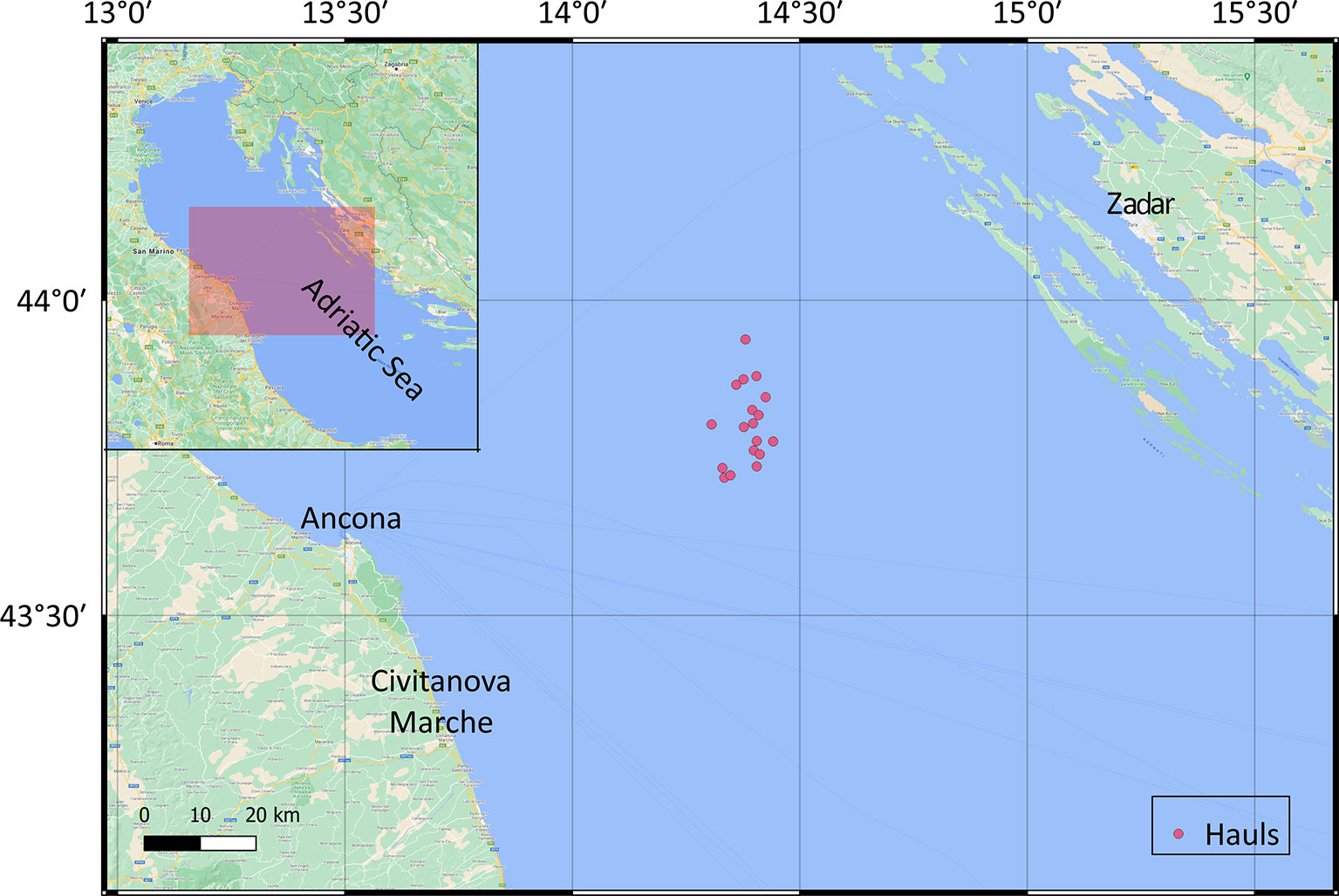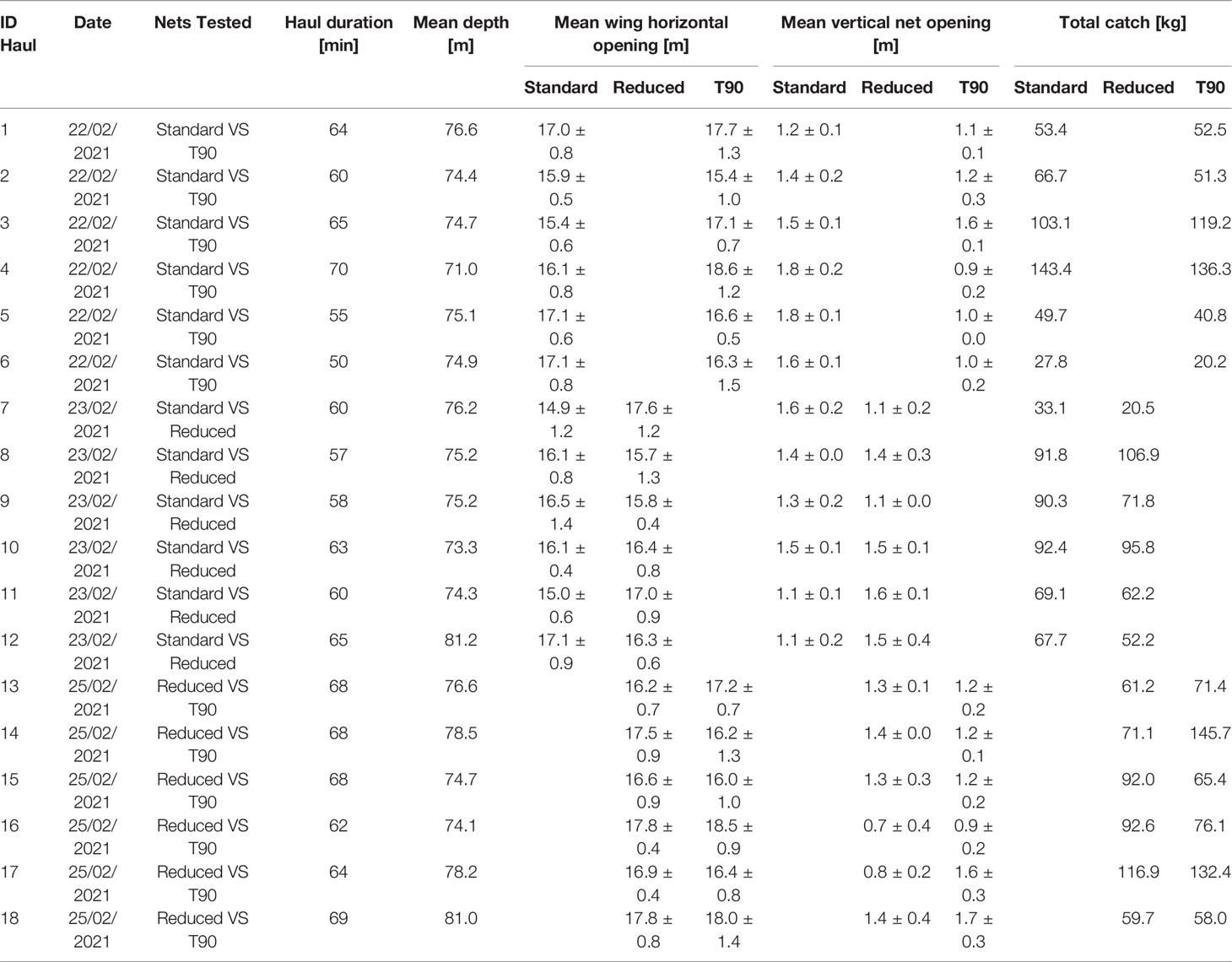- 1Department of Biological, Geological and Environmental Sciences (BIGEA), University of Bologna (UNIBO), Bologna, Italy
- 2Institute for Biological Resources and Marine Biotechnologies (IRBIM), National Research Council (CNR), Ancona, Italy
- 3The Norwegian College of Fishery Science, UiT The Arctic University of Norway, Tromsø, Norway
- 4SINTEF Ocean, Trondheim, Norway
- 5DTU Aqua, Technical University of Denmark, Hirtshals, Denmark
The catch composition of bottom trawls is commonly refined and improved through changes in codend design. Measures like reducing the number of meshes in codend circumference or turning diamond netting by 90 degrees are well known to improve the size selectivity of fish species with rounded cross-sectional shape. Based on this we speculated whether the same measures, if applied in other parts of a bottom trawl, would provide similar benefits as in the codend. Therefore, experiments were carried out by deploying these changes to the trawl extension piece in a Mediterranean bottom trawl fishery. However, for European hake and monkfish, results showed no indication of improved selectivity or catch pattern compared to the standard extension piece in the trawl. Contrary, for red mullet, one of the most important species in this fishery, reducing the number of meshes in the circumference of the extension piece jeopardized the size selection obtained in the trawl with a standard extension piece. The lesson learnt from this study was that the design changes that work for the codend do not necessarily work for other parts of the trawl. In fact, they can even have negative effects.
1 Introduction
The Mediterranean bottom trawl fisheries are multi-species. The variability in factors such as body size, morphology, behaviour, and minimum conservation reference size (MCRS) between the different species makes it challenging to identify one technical solution, for the trawl net, that avoids the retention of juveniles and simultaneously ensures that the retained catch is enough for the viability of the fishery. In recent decades, most of the scientific studies in the Mediterranean regarding trawl selectivity focused on experiments in the codend (see review by Lucchetti et al., 2021). The current regulatory framework requires 40 mm square meshes or, alternatively, 50 mm diamond meshes for the codend of trawl nets (EU, 2019). However, these codends still retain undersized and immature individuals of several species (Lucchetti et al., 2021) and contribute to producing high discard rates, approximately 20%-65% of the total catch, according to Tsagarakis et al. (2014).
Besides increasing the mesh size, the codend size selectivity can be improved by applying design changes that increase the mesh openness. This is well established for diamond mesh codends (Herrmann et al., 2009) and also confirmed for square mesh codends (Sala et al., 2016). For example, a reduction in the number of meshes in circumference increases the mesh openness in both diamond (Sala and Lucchetti, 2010; Tokaç et al., 2016) and square mesh codends (Sala et al., 2016). Another option resides in the change to a different mesh configuration, such as rotating the mesh orientation by 90° in relation to the towing direction, so called T90 (Wienbeck et al., 2011). The rotation of the traditional diamond mesh netting by 90° allows meshes to remain more open under the drag forces action due to the catch accumulation, enabling smaller specimens to escape (Herrmann et al., 2007; Madsen et al., 2012; Cheng et al., 2022). A T90 codend, like the square mesh codend, generally provides a significantly higher size selectivity than the diamond mesh codend, especially for those species with a rounded cross-section morphology (Tokaç et al., 2014; Deval et al., 2016; Petetta et al., 2020). The combined effect of both a reduction in the number of meshes in circumference and a shift to the T90 mesh configuration gave better selection results than those determined where the two factors were applied separately (Herrmann et al., 2007; Wienbeck et al., 2011).
Given the benefits obtained in trawl selectivity by reducing codend number of meshes in circumference and turning meshes by 90 degrees, we speculated that we might improve trawl selectivity by making similar design changes in other parts of the trawl, for example, in the extension piece in front of the codend. The extension piece is the rearmost part of the trawl body (tapered or untapered section) before the codend, made of one or more panels of the same netting characteristics (mesh size, mesh configuration, twine diameter and material). In a Mediterranean bottom trawl, its length ranges from 3 to 17 meters (Sala, 2013). The selectivity processes occurring in the trawl extension pieces have been less investigated than in the codend. Further, it is unknown to what extent design changes in the extension piece might affect the codend selectivity.
Based on the above considerations, the present study investigated the effect of reducing the number of meshes in circumference and turning meshes by 90 degrees in the extension piece of bottom trawls applied in the Mediterranean fishery. The main target species were the European hake (Merluccius merluccius) and the red mullet (Mullus barbatus), which are among the most landed and overexploited demersal species in the Mediterranean Sea, and require urgent management measures (GFCM, 2021). The monkfish (Lophius spp.) is another commercially important species in this fishery (Lucchetti, 2008). Specifically, this study aimed to answer to the following research questions:
i) In what way does reducing the number of meshes in circumference in the extension piece affect the catch patterns in the trawl and the catch efficiency at size of European hake and red mullet compared to the standard extension pieces?
ii) In what way does turning the meshes by 90 degrees in the extension piece affect the catch patterns in the trawl and the catch efficiency at size of European hake and red mullet compared to the standard extension pieces?
iii) Is there a change in the species composition and species dominance when applying these technical modifications?
2 Materials and Methods
2.1 Sea Trials and Data Collection
Fishing trials were performed in February 2021 in the North-western Adriatic Sea (FAO Geographical Sub-Area 17) with a commercial bottom trawler (F/V ‘Braveheart’; overall length: 22.2 m; gross tonnage: 64 GT).
The experiments were carried out with twin trawls, i.e., the trawler simultaneously towed two identical trawls side by side. The gears used were the typical commercial bottom trawl nets employed in the area (‘Americana’ trawls). Each trawl was an asymmetrical 4-face net with an overall length of 41.6 m, a 33.2 m long headrope (Ø 16 mm, polyethylene material) and a 40 m long footrope (Ø 34 mm, polyamide-polyethylene combined material). A single pair of otter boards (186×114 cm, 390 kg each) and one central clump (190 kg) were used to maintain the horizontal opening of the two nets. The otter boards and the clump were attached to the trawls with double 20 m long sweeps and 6 m long bridles. The traditional extension piece (Standard, hereafter) was cylindrical, with a total length of 9.5 m, a 44 mm nominal diamond mesh size and 240 meshes in circumference. Two experimental extension pieces were designed: one having 44 mm (nominal) diamond meshes and a reduced (170) number of meshes in circumference (Reduced, hereafter); the second having 44 mm (nominal) T90 meshes and 170 meshes in circumference (T90, hereafter). The three extension pieces were constructed from the same netting panel and identical 40 mm legal square mesh codends (4 m long) were attached to each of them. The mesh openings of both extension pieces and codends were measured in wet conditions with the OMEGA mesh gauge (Fonteyne et al., 2007). The resulting three trawl configurations are schematized in Figure 1, and their specifications are listed in Table 1.
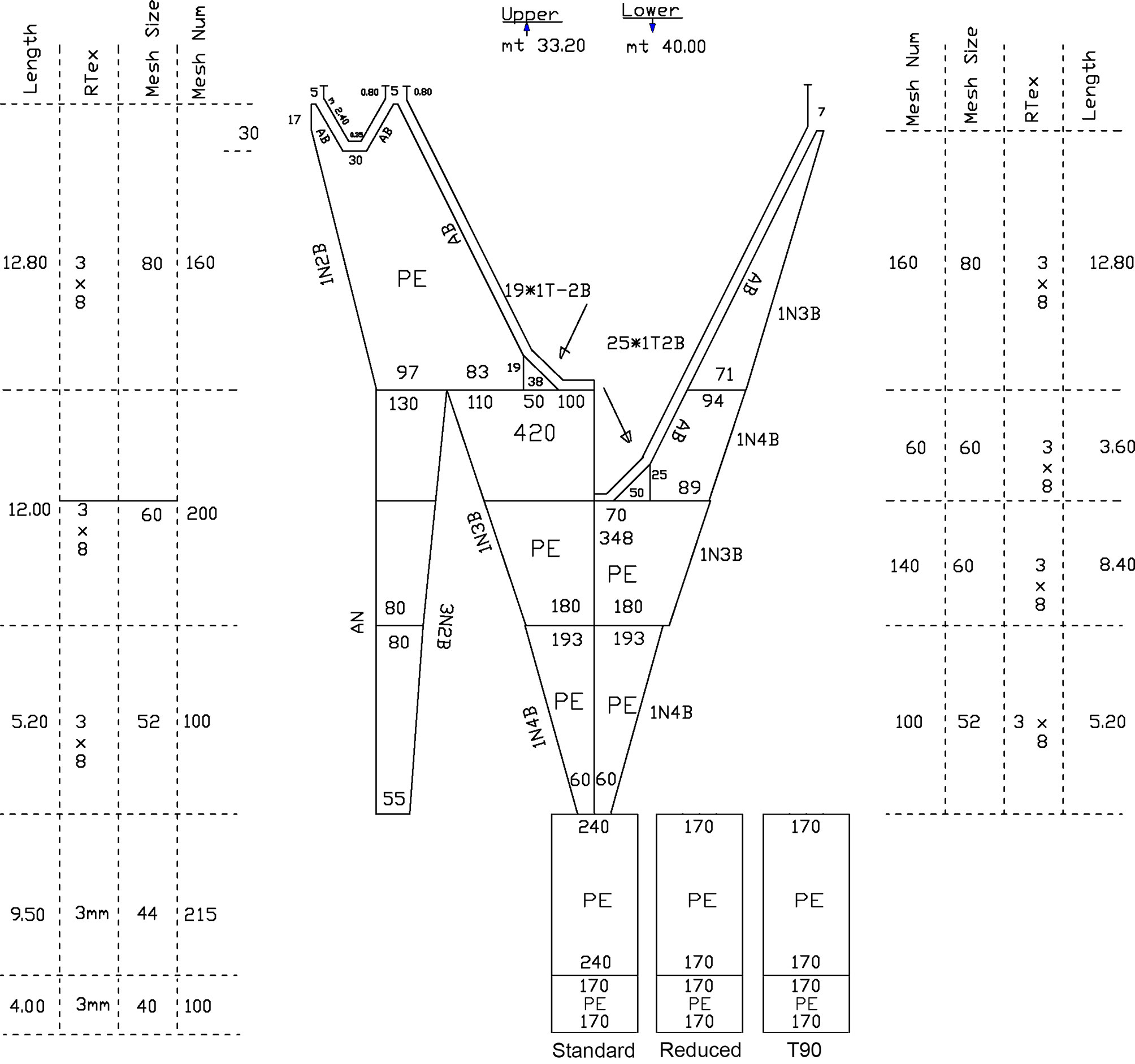
Figure 1 Scheme of the trawl net used in the survey, with details of the extension piece plus codend of the three net configurations tested in the survey (Standard, Reduced, T90).

Table 1 Technical features of the extension piece plus codend of the three net configurations (Standard, Reduced, T90) tested in the survey.
The experiment consisted in testing two of the three net configurations at a time. Eighteen valid hauls were performed: six hauls T90 vs. Standard; six hauls Reduced vs. Standard; six hauls Reduced vs. T90. Therefore, we obtained a total of 36 samples (12 samples for each net configuration). An overview of the hauls is presented in Figure 2 and Table 2.
During the towing operations, the two nets were equipped with acoustic sensors (SIMRAD, Norway) to monitor their geometry, i.e., the net vertical opening and the wing horizontal openings.
The average duration of each haul was 60 minutes (range 50 to 70 minutes) and the towing speed was maintained at 3.5 to 3.6 knots, as in commercial fishing conditions. The catches of the two nets were kept separate. In each haul, the total weight and number of the most abundant species were recorded. Regarding the two target species (European hake and red mullet) and the monkfish (Lophius spp.), the individual lengths were measured to the lowest 0.5 cm without sub-sampling. An exception concerned the red mullet, where in case of large catches, measurements were conducted on a randomly selected subsample.
2.2 Data Analysis
The Kruskal–Wallis H test (χ2) was first applied to seek differences between the wing horizontal openings and vertical net openings of the three configurations tested. The check of the net geometry was preparatory to further analyses, to be sure to have the same fishing effort between the trawls simultaneously towed.
2.2.1 Catch Comparison and Catch Ratio Analysis
The catch data were analysed with the statistical software SELNET (Herrmann et al., 2012). Although the experimental design was based on six paired hauls for each combination (T90 vs. Standard, Reduced vs. Standard, Reduced vs. T90), each net configuration was tested two times, by comparing it to the other two configurations. Therefore, data were treated as unpaired (Herrmann et al., 2017), to be able to include in the comparison analyses all 12 hauls obtained from each net configuration.
The length measurements for the red mullet, the European hake, and the monkfish obtained with the Standard, Reduced and T90 extension pieces in the trawl were used to perform a catch comparison and catch ratio analysis. The analysis investigated the size dependent effect on the catch efficiency by changing the extension piece configuration and was carried out independently for each species following the description below.
To assess the relative length-dependent catch comparison rate (CCl) of changing from one trawl net configuration to another, we used Equation 1 (Herrmann et al., 2017):
where nbli and ntlj are the number of fish of length l of a given species retained by the codend of the baseline (b) and test (t) net, respectively. Parameters qbi and qtj are the subsampling ratios, i.e., the ratio of the measured to the total number individuals retained by the baseline and the test net, respectively. Parameters hb and ht represent the total number of hauls conducted with baseline and test extension piece, respectively. The catch comparison rate CC(l,v), experimentally expressed by Equation 1, was estimated using the maximum likelihood estimation by minimizing the Expression 2
where the outer summation is over the length classes l and the inner summation is over the hauls ht and hb in the experimental dataset. The v parameter describes the catch comparison curve defined by CC(l,v). The experimental CCl was modelled by the function CC(l,v):
where f is a polynomial of order k with coefficients v0 to vk, such that v = (v0, …, vk). We considered f of up to an order of 4. Leaving out one or more of the parameters v0…v4 yielded 31 additional candidate models for the catch comparison function CC(l,v). Among these models, the catch comparison rate was estimated using the multi-model inference to obtain a combined model (Burnham and Anderson, 2002; Herrmann et al., 2017). The ability of the combined model to describe the experimental data was based on the p-value, which is calculated based on the model deviance versus the degrees of freedom (DOF; Wileman et al., 1996; Herrmann et al., 2017). Thus, suitable fit statistics for the combined model to describe the experimental data sufficiently well should include a p-value > 0.05. In case of poor fit statistics (p-value < 0.05 and deviance/DOF >> 1), the residuals were inspected to determine whether the result was due to structural problems when modelling the experimental data, or to overdispersion in the data (Wileman et al., 1996). CC(l,v) quantifies the probability that a fish of length l is retained by the codend of the test net, provided that it is retained in one of the two nets compared. A CC(l) of 0.5 indicates that a fish of length l has the same probability of being retained by either gear. Therefore, CC(l,v) cannot be used to provide a direct relative value of the catch efficiency between the test and the baseline nets. The following catch ratio CR(l,v) equation was then used:
In this case a CR(l,v) of 1.0 indicates that the catch efficiency of both nets is equal, while a CR(l,v) = 0.25 indicates that the test net is catching only 25% of the fish of length l compared to the baseline net.
The 95% confidence intervals (CIs) for the catch comparison and catch ratio curves were estimated using a double bootstrapping method with 1000 bootstrap repetitions, following the description in Lomeli (2019).
2.2.2 Discard Ratio Analysis
For the species analysed with a MCRS we estimated the discard ratio, i.e., the ratio between the individuals below MCRS to the total individuals retained in the codends of each net configuration (Sala et al., 2015). The indicators provided below represent a summary of the relative catch performance of the technical modifications applied. The discard ratios were estimated (in percentage) directly from the experimental catch data by using the following equation:
The outer summations include the length classes that were below the MCRS (in the nominator) and overall length classes (in the denominator). The above indicators are based on number of individuals, but since the value of catch is more related to weight, we estimated similar indicators based on weight (WDRatio) where the weight Wl, for individual belonging to length class l, have been estimated by:
The length-weight relationships of the species analysed were derived from the study of Bolognini et al. (2013) carried out in the same area.
We estimated the uncertainties (in 95% CIs) for both NDRatio and WDRatio by using the double bootstrapping method described in Lomeli (2019).
2.2.3 Catch Dominance Analysis
Catch dominance curves are often used to quantify information about the pattern of relative species abundances for a given sample. In the present study, the objective was to assess if the species abundances significantly changed among the three configurations tested. Generally, dominance curves are based on ranking of species in a sample in decreasing order of their abundance (Clarke, 1990). Here we assigned a fixed rank to the most abundant species caught in the sea trials following these criteria (in order of importance): i) the abundance in the commercial catch, ii) the importance in the fishery, iii) the abundance in the discarded catch, iv) the belonging to a vulnerable category.
We then estimated the catch dominance curve for each net configuration using the following equation (Warwick et al., 2008):
where j represents the haul and i is the species index (species rank) that was predefined. nij is the number of individuals of the species i being counted in the subsample in haul j. wij is the weight of the counted subsample of species i in haul j, whereas Wij is the total weight caught of species i in haul j. Q is the total number of species considered.
To better represent species dominance patterns, we also estimated the cumulative dominance curves as follows:
where I is the species index summed up to in the nominator.
The 95% CIs for the dominance patterns were estimated by using (7) and (8) inside each of the bootstrap iterations applied to estimate the uncertainties for the catch comparison and catch ratio curves.
3 Results
3.1 Gear Performance and Catch Data
The Kruskal–Wallis H test (χ2) revealed no significant differences in the net openings (m) between the nets towed (χ2 = 4.46, df = 2, p = 0.1075 for wing horizontal opening; χ2 = 4.13, df = 2, p = 0.1266 for vertical net opening; see Table 2 for details).
The red mullet represented the largest portion of the commercial catch (up to 24 kg per haul and net; avg. 9.1 ± 5.0 kg), while the European hake catch showed a maximum of 10 kg per haul and net (avg. 6.2 ± 2.2 kg). The average catch of monkfish in each haul and net was 4.4 ± 2.0 kg. Additional 21 species (fish, cephalopods, and crustaceans) caught in large amounts in most of the hauls, were counted and weighted in each haul and net.
3.2 Catch Comparison Analysis
For the three species included in the catch comparison analysis, the summary of the individuals measured in each haul from the three net configurations is reported in Table 3.The fit statistics of the combined model are given in Table 4. Regarding red mullet and monkfish, the p-values were always ≤ 0.05. However, the visual inspection of the modelled catch comparison curves against the experimental rates for these species did not indicate any length dependent patterns in the deviations (Figures 4, 5). Therefore, we assumed that the low p-values were due to overdispersion in the experimental rates rather than a lack of fit.
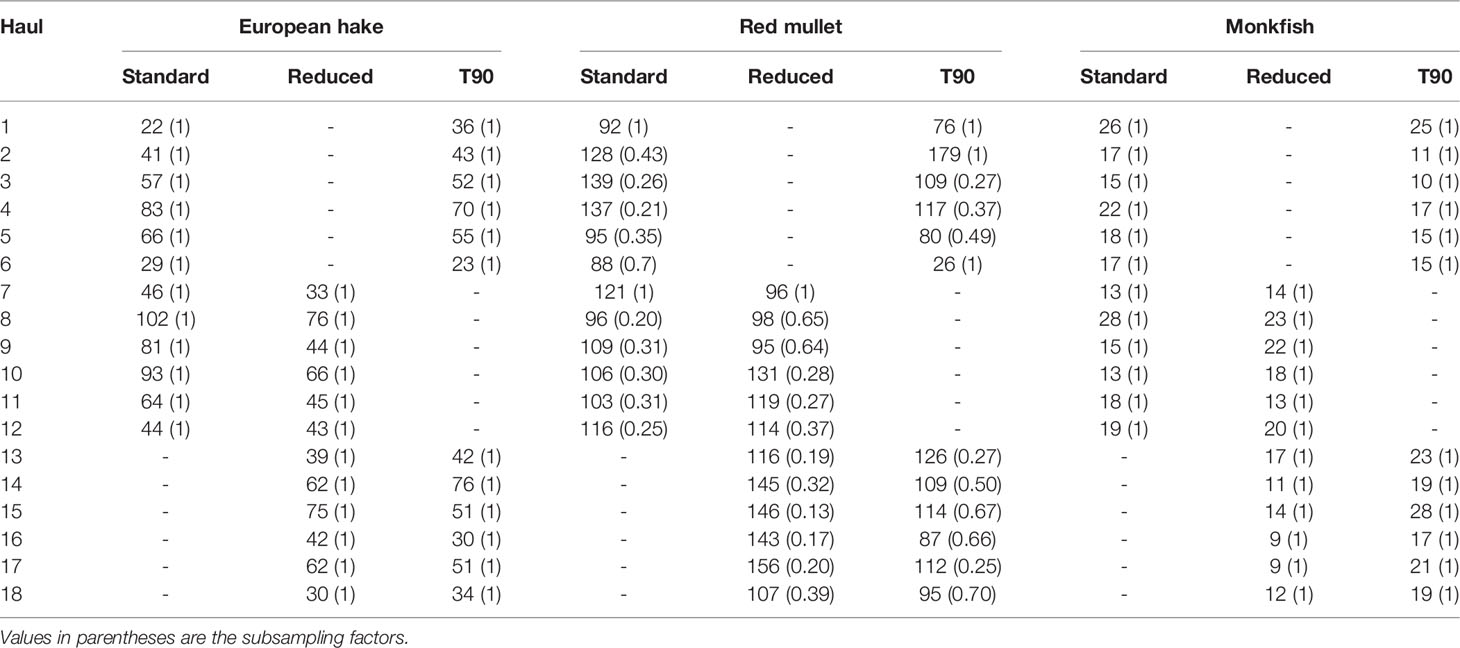
Table 3 Number of individuals of the three species (European hake, red mullet, monkfish) measured in each haul from each net configuration.

Table 4 Fit statistics of the combined model used in the three catch comparisons (T90 VS Standard, Reduced VS Standard, Reduced VS T90).
Figures 3-5 show the catch comparison and catch ratio results of T90 vs. Standard, Reduced vs. Standard, Reduced vs. T90 for European hake, red mullet, and monkfish, respectively.
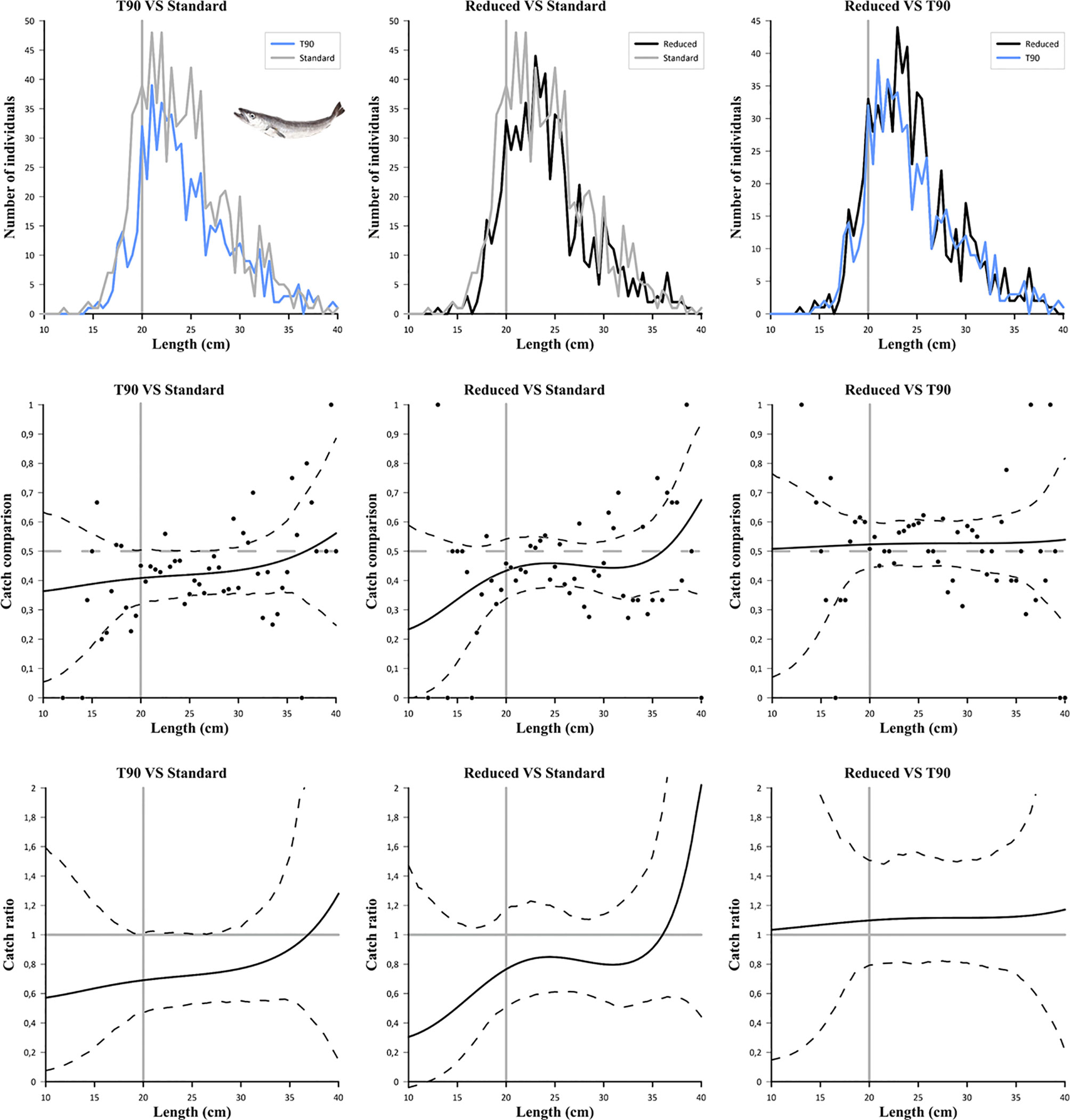
Figure 3 Upper graph: Length frequency distribution of European hakes caught by the configurations tested (Standard, Reduced and T90). Middle graph represents the modelled catch comparison rate, and lower graph the catch ratio (black line). Black circles represent the experimental rate, and the black stippled curves represent 95% CIs. The grey horizontal line at 0.5 and 1.0 represents the point at which both configurations have equal catch rates. The grey vertical line represents the MCRS for hake.
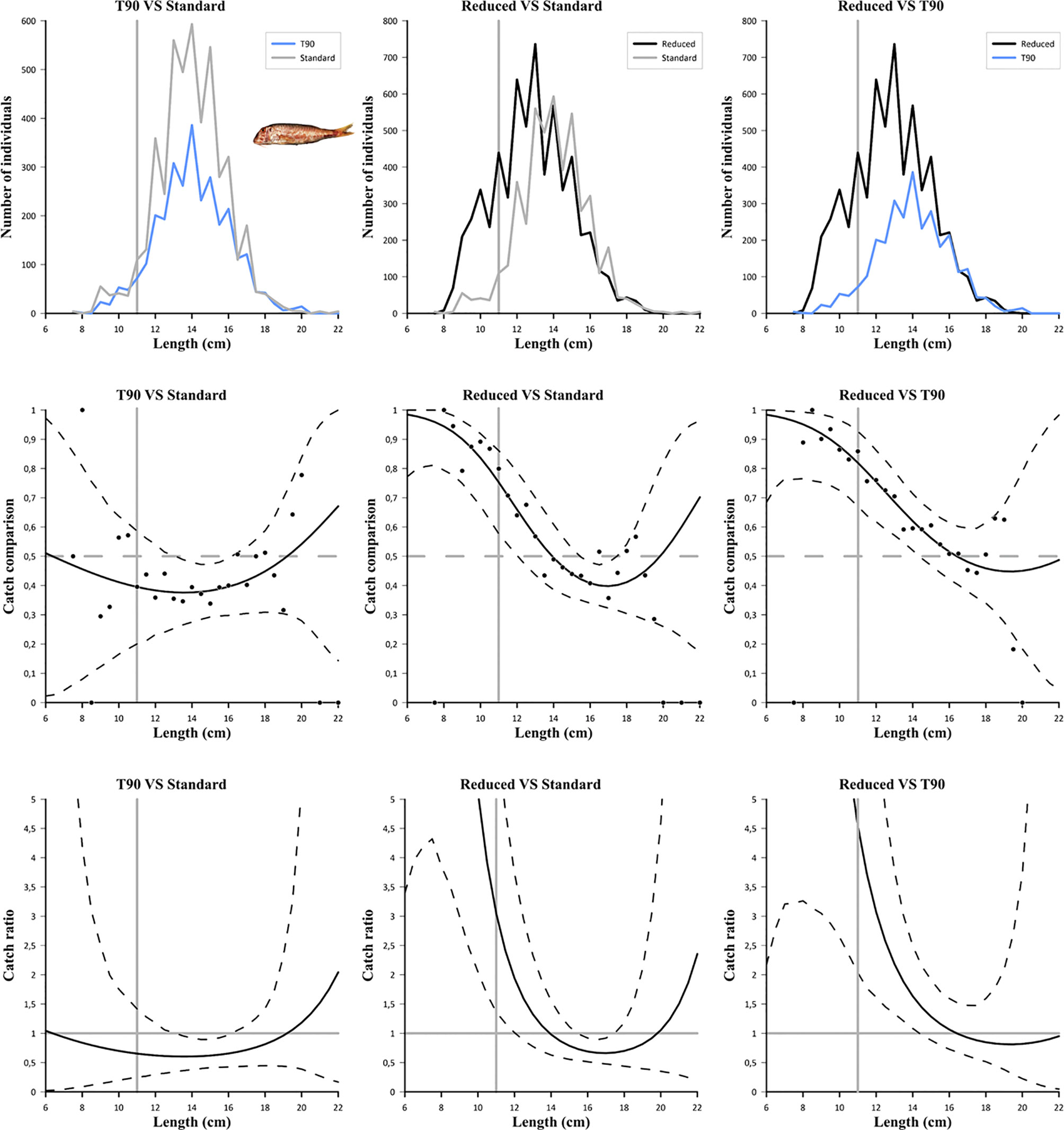
Figure 4 Upper graph: Length frequency distribution of red mullets caught by the configurations tested (Standard, Reduced and T90). Middle graph represents the modelled catch comparison rate, and lower graph the catch ratio (black line). Black circles represent the experimental rate, and the black stippled curves represent 95% CIs. The grey horizontal line at 0.5 and 1.0 represents the point at which both configurations have equal catch rates. The grey vertical line represents the MCRS for red mullet.
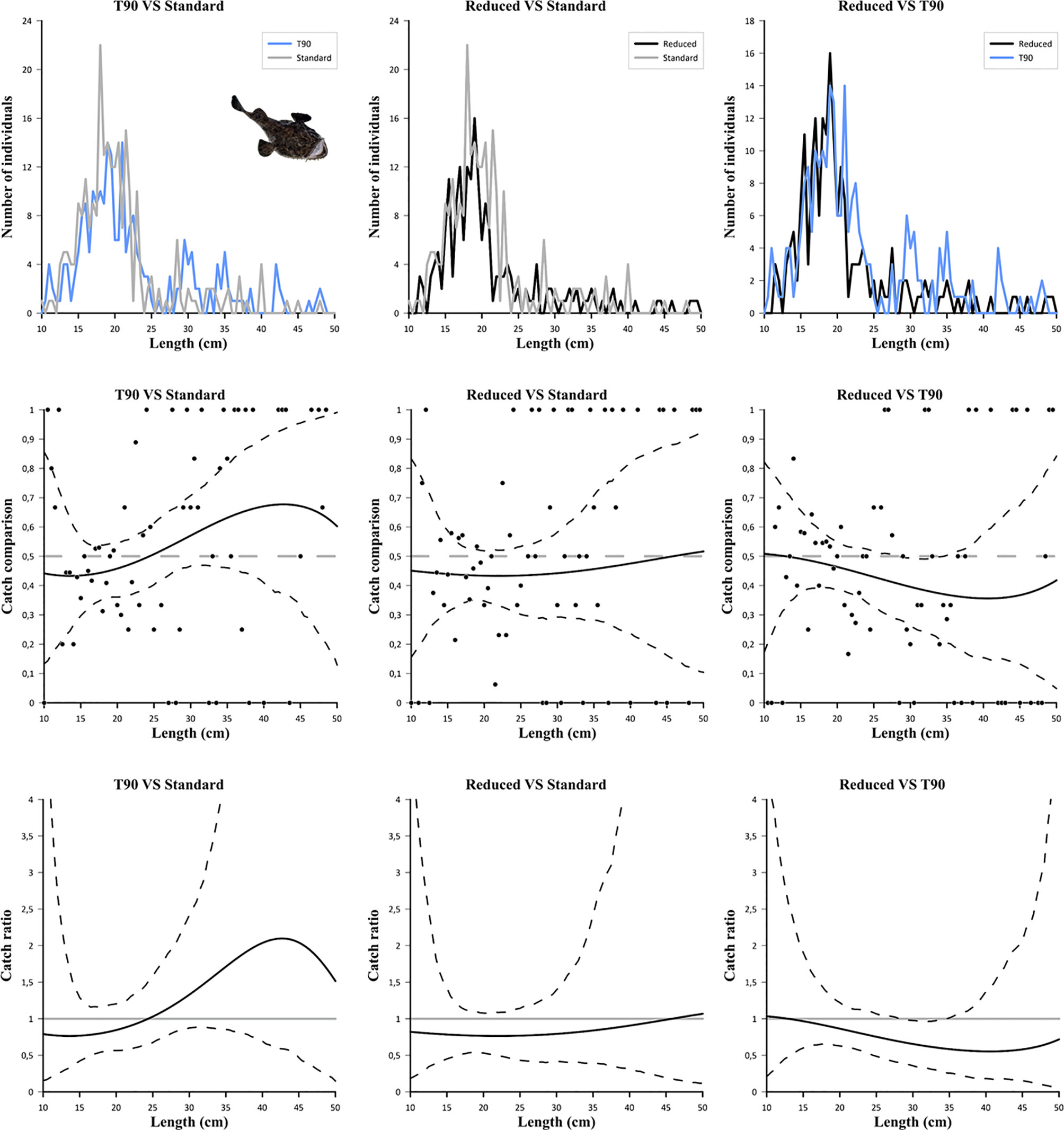
Figure 5 Upper graph: Length frequency distribution of monkfish caught by the configurations tested (Standard, Reduced and T90). Middle graph represents the modelled catch comparison rate, and lower graph the catch ratio (black line). Black circles represent the experimental rate, and black stippled curves represent 95% CIs. The grey horizontal line at 0.5 and 1.0 represents the point at which both configurations have equal catch rates.
The use of the two modified net configurations (Reduced, T90) did not affect the catch efficiency of European hake, since the CIs of both the catch ratio and catch comparison curves overlapped the horizontal line representing equal catch rates between the two configurations compared, for the full length range observed (Figure 3).
Regarding red mullet, a significant difference was found in all three comparisons (Figure 4). The length frequency distribution obtained in the T90 was different from that of Standard, especially in the 13 to 16 cm length range. This was reflected in both catch comparison and catch ratio curves, which displayed a significantly lower catch efficiency of T90 compared to Standard for those length classes. The catch comparison and catch ratio curves of Reduced vs. Standard and Reduced vs. T90 had a similar trend. In both cases, a significantly higher retention of Reduced was observed for the lengths ranging from 6 to 12 cm (vs. Standard) and from 6 to 14 cm (vs. T90). Moreover, in the comparison between Reduced and Standard, the former had a significantly lower catch efficiency than the latter for around 16 to 18 cm long individuals.
The results displayed for monkfish did not reveal any significant differences in T90 vs. Standard and Reduced vs. Standard (Figure 5). A significant difference was found in the Reduced vs. T90 comparison: the catch efficiency of the latter was found to be lower than that of the former for the 30 to 35 cm length range. However, the difference was minimal, since the upper CI of both the catch comparison and catch ratio curves almost reached the equal catch rate values of 0.5 and 1.0, respectively.
3.3 Discard Ratio Analysis
Regarding European hake, the discard ratios representing the proportion of individuals below the MCRS did not significantly differ between the Reduced net (NDRatio: 11.8%, CIs: 8.7%–15.1%; WDRatio: 4.1%, CIs: 2.9%-5.5%) and the other two nets (Table 5).

Table 5 Estimated discard ratios (%) in both numbers (NDRatio) and weight (WDRatio) of European hake and red mullet obtained from the three net configurations.
Regarding red mullet, the discard ratios of the Reduced net (NDRatio: 17.9%, CIs: 11.8%–22.4%; WDRatio: 7.3%, CIs: 4.5%-9.6%) were significantly higher than those of Standard (NDRatio: 3.8%, CIs: 2.6%–5.1%; WDRatio: 1.2%, CIs: 0.8%-1.6%) and T90 (NDRatio: 5.0%, CIs: 1.8%–9.3%; WDRatio: 1.7%, CIs: 0.6%-3.2%) nets (Table 5).
3.4 Catch Dominance Analysis
All 24 species counted and weighted in each haul were included in the catch dominance analysis. Table 6 shows the catch dominance percentages in weight of each species in each net configuration (Standard, Reduced, T90). In all three configurations, the red mullet was found to be the dominant species, ranging from 24.3% (CIs 19.1%-29.4%) of the total catch in the T90 to 31.5% (CIs 27.0%-35.8%) in the Standard and 35.6% (CIs 27.3%-42.4%) in the Reduced; the differences among nets were not significant. The European hake showed a similar percentage among the three nets (around 20%, CIs between 17.3% and 26.3%). Regarding monkfish, the T90 showed a significantly higher percentage (20.1%, CIs 16.2%-25.3%) than the Reduced (11.8%, CIs 9.4%-14.8%); the difference was not significant when compared to the Standard (13.5%, CIs 10.3%-17.4%). The spotted flounder (Citharus linguatula) resulted to be the fourth commercial species in terms of weight in all the nets (around 5%-8% of the total catch). Among the discarded species, the common pandora (Pagellus erythrinus) and the small spotted catshark (Scyliorhinus canicula) had the highest percentages (around 4%-6%), without significant differences among the three nets.
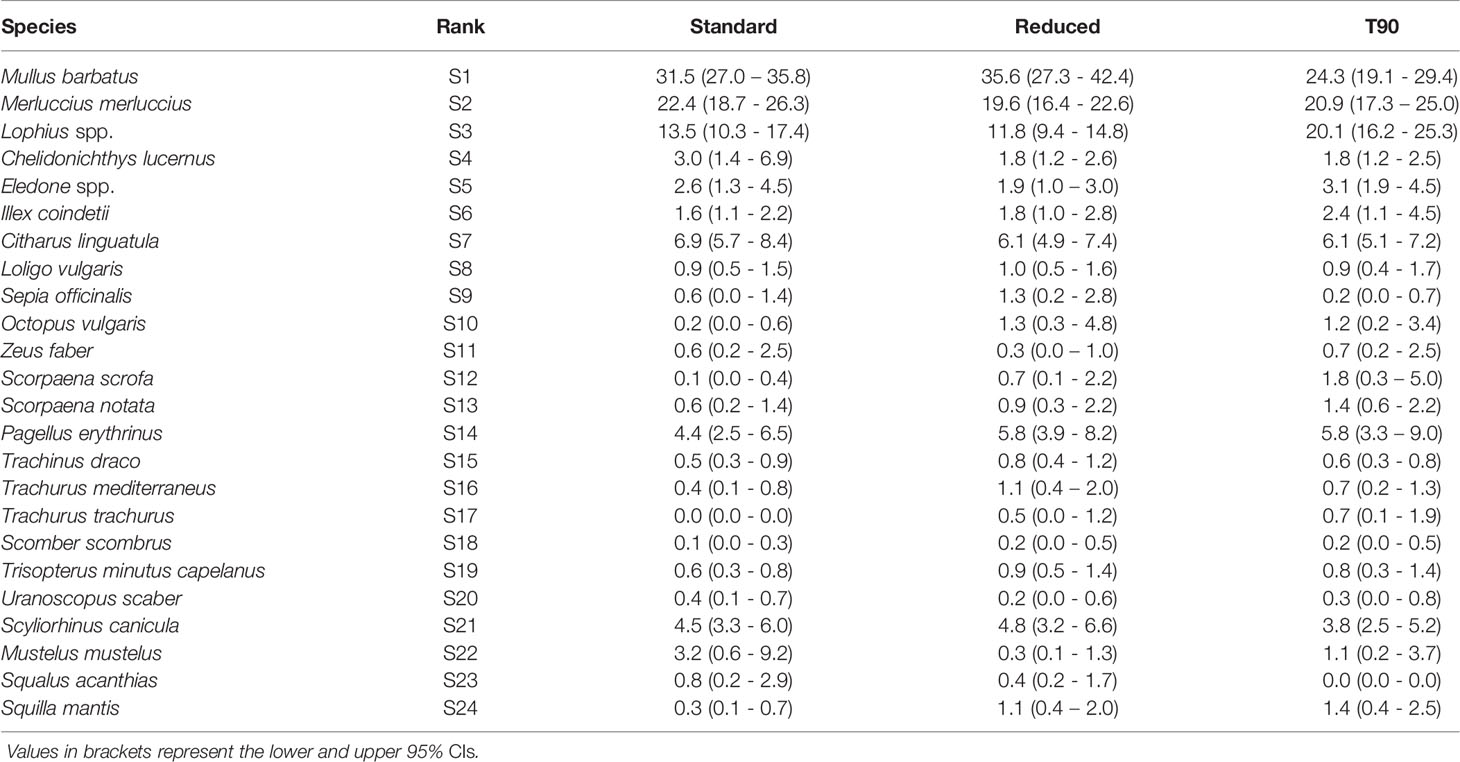
Table 6 Catch dominance percentages of each species in the three net configurations tested (Standard, Reduced, T90).
The catch dominance cumulative curves obtained by summing the percentages of the 24 species for each net configuration are presented in Figure 6. No significant differences were detected between the three nets since the CIs always showed overlap. The three main target species (red mullet, European hake, and monkfish) represented 60%-70% in weight of the total species selected.
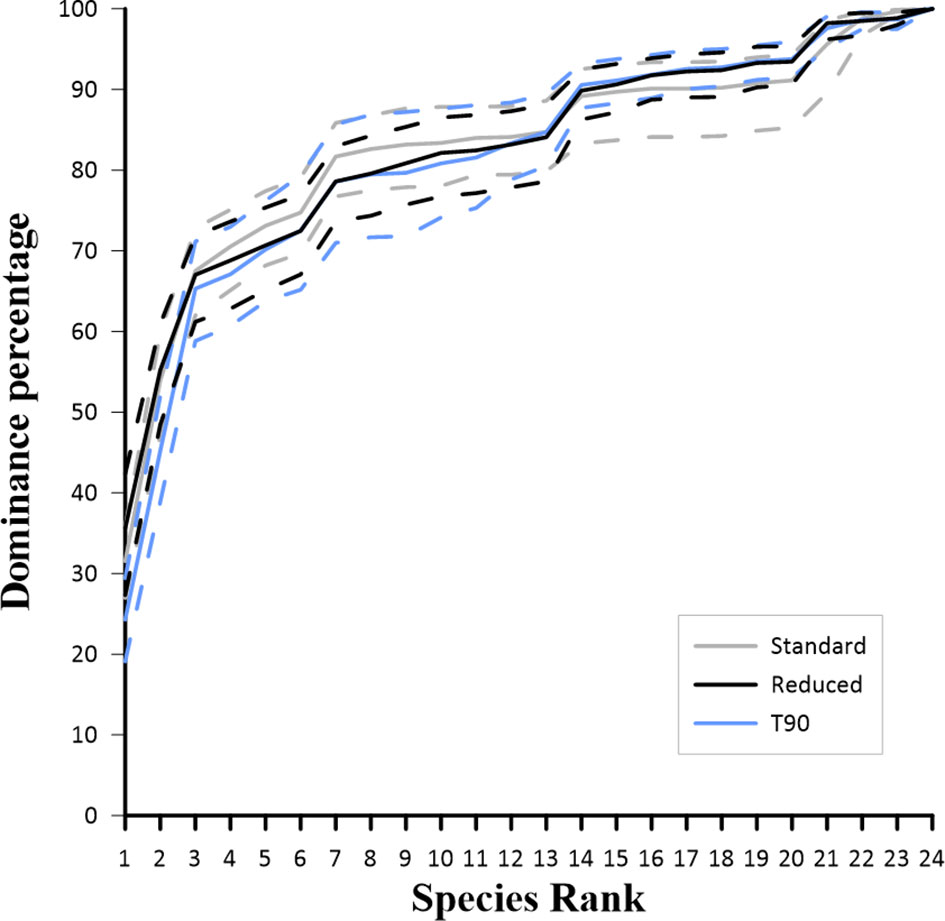
Figure 6 Catch dominance cumulative curves for the three configurations tested (Standard, Reduced, T90). The stippled curves represent the 95% CIs.
4 Discussion
The modification of standard trawls to decrease unwanted size and species retention is one of the most intensively investigated approaches in Mediterranean bottom trawl fisheries in light of the landing obligation regulation (EU, 2013), which encourages the adoption of technical solutions to reduce discards (Petetta et al., 2021). The aim of the present study was to test, in the extension piece section, simple technical modifications, the efficacy of which has been demonstrated at the codend level (Wienbeck et al., 2011; Sala et al., 2016).
The main finding was that the design changes that work in the codend do not necessarily work in other parts of the trawl, and the outcomes can even opposite to expected outcomes. This was evident from the results of the red mullet, where the only modification of reducing the number of meshes in extension circumference led to a higher retention of the smallest size classes compared to the standard net. One can speculate that the combination of two mechanisms led to these results:
i) Although a reduction of number of meshes in circumference increases the mesh openness in the extension piece, the main behaviour of red mullets is to stay clear of the meshes in this section until they reach the codend. This is a common behaviour of several fish species when entering the relatively confined section of netting ahead of the codend; after swimming in the towing direction without escape attempts, the progressive exhaustion leads to a consequent drift towards the codend (Grimaldo et al., 2007; He et al., 2008; Winger et al., 2010). In particular, the size of the smallest red mullets (6 to 12 cm) prevents them from swimming for long periods in the opposite direction to the water flow, so that there is little chance of contact with the extension piece netting. On the contrary, most of the escape attempts occur at the codend, especially during the haul-back operations (Madsen et al., 2012). Therefore, in this hypothesis, the extension piece does not contribute to the size selection.
ii) The fewer meshes in circumference reduces the diameter of the extension piece and, since it is connected to the codend, it also reduces the diameter of the codend. In fact, the change in the ratio between the fewer extension meshes and the codend meshes, which remain constant, leads to a smaller circumferential length for each codend mesh, causing a reduced mesh openness or creating a folding of the codend netting (Figure 7). The netting folding is an important factor to take into account when addressing selectivity issues, since it can contribute to decreasing the codend size selectivity (Wienbeck et al., 2011). It is also possible that a selectivity improvement through the extension piece occurred, and it was hidden by a reduced selectivity in the codend due to folding. However, this issue is already prevented by EC, 2006, which establishes that, in gears equipped with 40 mm square mesh codends, the circumference of the posterior ending of the extension must be between 2 and 4 times the circumference of the anterior part of the codend. Hence, in a commercial context, it is not possible to apply this mesh reduction without modifying the codend accordingly, to maintain the proportions defined in the Regulation.
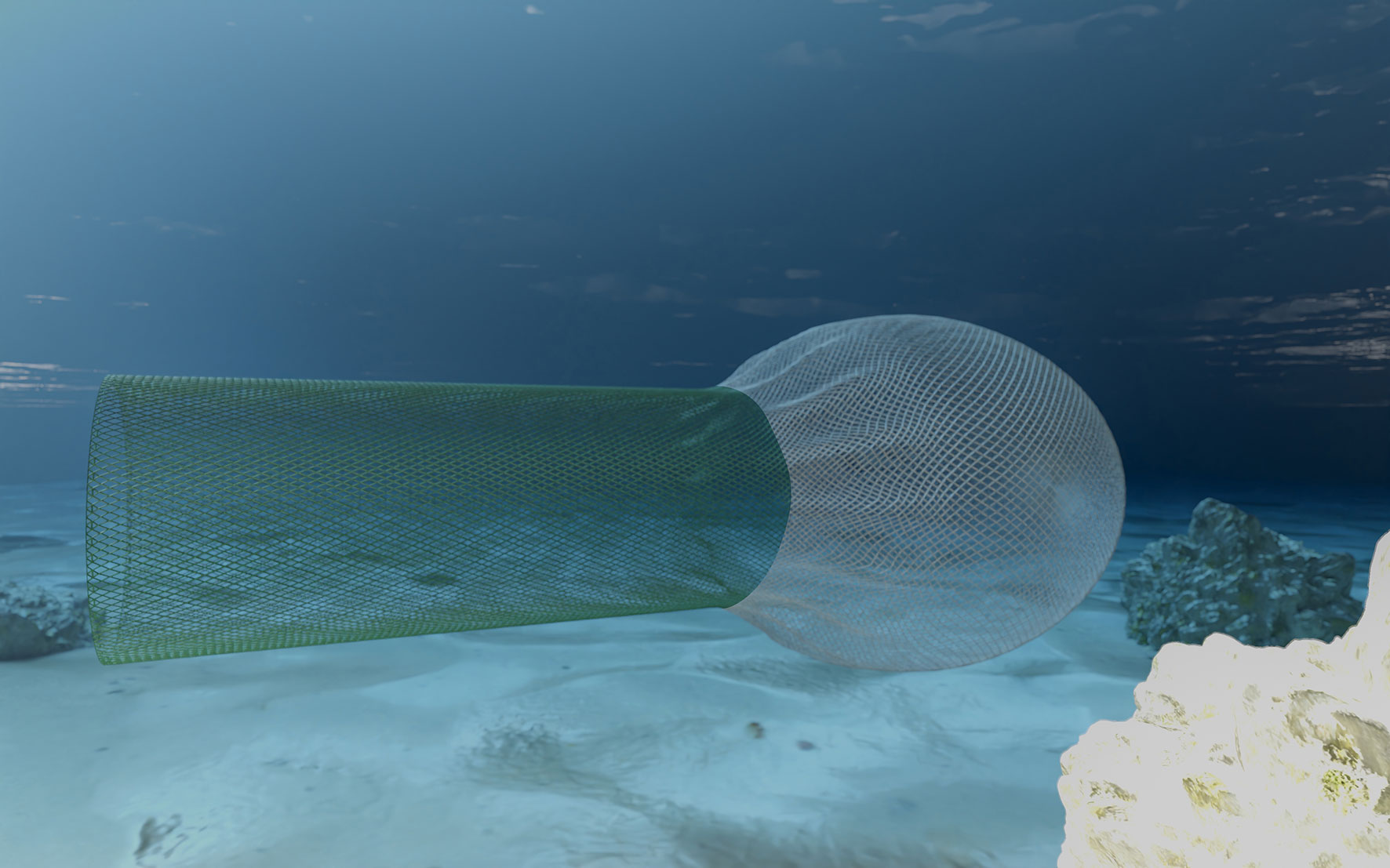
Figure 7 Illustration of the hypothetical codend folding due to a reduction of the number of meshes in the extension piece circumference.
We also cannot rule out that these mechanisms described in i) and ii) occurred simultaneously. As a result, they reduced the escape possibilities for red mullets up to a certain length which, with the actual 40.4 mm codend mesh size, should be around 11 to 14 cm, based on the average L50 range estimated for codends with similar properties in the Mediterranean (Table 7). This length range well fits to the obtained catch ratio curve for this species in the Reduced vs. Standard comparison (Figure 4).

Table 7 Selectivity values (L50 and selection range, SR) obtained for red mullet, European hake and monkfish in selectivity experiments carried out in different FAO Geographical Sub-Areas (GSAs) of the Mediterranean with a 40 mm square mesh codend.
The same effect was not observed in the T90, when compared to Standard, since the reduced number of meshes was applied together with the T90 configuration. In fact, the T90 configuration allowed meshes to remain more open and therefore did not consistently reduce the extension diameter (Herrmann et al., 2007). This explains why we observed the same catch pattern in Reduced vs. T90 as in Reduced vs. Standard, while there was no difference in the catch efficiency of T90 vs. Standard for the smallest length classes (< 12 cm). On the contrary, the lower catch efficiency of T90 than of Standard for larger individuals (13 to 16 cm long) could be related to their more active swimming behaviour, and their consequent greater use of the T90 meshes to escape. Concerning the biggest individuals (> 16 cm), they were probably not able to pass through the 43.8 mm meshes due to physical impediments. Therefore, the selectivity improvement carried out by the T90 meshes was essentially concentrated on individuals between 13 and 16 cm, which represented the most abundant size classes. These results are in line with the catch patterns observed by Bonanomi et al. (2020) for the same species in the same area, when applying lateral 70 mm square mesh panels in the extension piece.
Regarding the European hake, the reason why we did not observe the same catch pattern as in red mullet could reside in the size of the individuals caught. In fact, very few individuals below 15 cm were caught in the experiment, and this is confirmed by the average L50 range (13 to 16 cm) estimated for the 40 mm square mesh codend in several Mediterranean studies (Table 7). Most of the hakes caught in our experiment were simply too big for being released through the codend meshes, regardless of their openness. Therefore, the effect of the Reduced net on the reduction of codend selectivity especially due to the folding was not evident for this species. Both catch ratio curves and discard ratio indicators showed that the T90 net had a lower catch efficiency for 15 to 30 cm long hakes than the Standard net. Even if this trend was not significant, we could speculate that hakes used the 43.8 mm T90 meshes of the extension piece to escape, as assumed for the larger red mullets. We might have provided slightly different results with a higher sampling effort on the smaller individuals. Therefore, further tests may be needed in autumn or late spring, when the juveniles are more abundant in the study area (Sion et al., 2019; Zorica et al., 2021). We can also speculate if hakes made use of the whole extension piece to escape or only specific sections. In the Atlantic Ocean, Cuende et al. (2020) observed that placing an 82.7 mm square mesh panel in the lower extension piece section improved the release efficiency of 11 to 28 cm long hakes. On the contrary, Alzorriz et al. (2016) found that a 100 mm square mesh panel mounted on the top of the net was not an effective strategy to improve escape possibilities for hake. The underwater observations carried out by the authors showed that hakes simply drifted towards the codend when passing through the extension piece, without contacting the netting. The contact probability is a key issue for the selection devices placed in the extension piece, since fish must first physically contact the device for a size-dependent escape process to occur (Brčić et al., 2016; Cuende et al., 2020). This probability has been shown to increase when increasing the size of the selection devices and inserting guiding panels to enhance hake contact with the devices (Santos et al., 2016).
The results here displayed for both European hake and red mullet are different from those obtained in the Spanish Mediterranean. Sola and Maynou (2018) compared two extension pieces made of 50 mm T90 meshes and 53 mm diamond meshes, respectively. The authors observed a significant reduction, in the experimental net, of the catch of undersized individuals, but also of legal sized individuals. The same results were obtained by Maynou et al. (2021). They tested two experimental nets that, besides reducing the extension piece mesh size (50 mm T90 vs. 53 mm diamond of standard net), maintained or increased the number of meshes around extension circumference (210 and 220 vs. 210 of standard net) and, in the 40 mm square mesh codend, reduced the number of meshes around circumference (106 and 104 vs. 130 of standard net). Also, the length and position (forwards in the extension piece and immediately in front of the codend) of the T90 panels were changed. The simultaneous application of these several design changes could have caused additional processes to the ones described above, which influenced the overall trawl catch pattern. Moreover, it is difficult to examine and understand the effect of single modifications, compared to the present study.
The size selectivity of the 40 mm square mesh codend is very low for monkfish (L50 of 4.4 cm; Table 7). Therefore, the barely significant reduction in the catch efficiency of T90 compared to Reduced for 30 to 35 cm long individuals is probably due to the low number of measured individuals for that length range. Few individuals means a higher possibility of finding differences in their distribution in the surfaces swept by each trawl, even using a twin trawl, with the consequent high dispersion in the retention rates.
The catch dominance analysis did not show any significant differences in the catch composition among the three configurations tested. However, this method, innovative in the selectivity field, can provide useful information on the dynamics of species composition when applying different technical modifications.
The lesson learnt from this study is that the design changes that worked for the codend in previous studies do not necessarily work for other parts of the trawl such as the extension piece, which seems not to be the main part of the trawl where fish are willing to escape. This is in line with a dated study from Clark (1963), who showed that approximately 90% of the haddock (Melanogrammus aeglefinus) and silver hake (Merluccius bilinearis) escapement takes place in the very last few rows of meshes of the codend (also confirmed by Beverton, 1963). The only reduction in number of meshes around extension circumference produced an opposite result than expected, since it jeopardized the size selection obtained in the trawl with a standard extension piece. The T90 netting, which has been suggested as a cheap and practical solution in the codend to improve the size selectivity of Mediterranean bottom trawl fisheries (Tokaç et al., 2014; Kaykaç et al., 2018; Petetta et al., 2020), in the extension piece did not significantly help excluding juveniles of target species.
This study confirms that, to assess the validity of a technical solution, the factors involved (e.g., the T90 mesh in the extension and the reduction in number of meshes in circumference) should be tested one at a time, since the combination of different factors could mislead the obtained results.
The design changes in the codend remain the most urgent measures to be tested and applied in the commercial fisheries, to mitigate the biological impacts of bottom trawling in the Mediterranean. In fact, the simple use of a 40 mm square mesh codend is not sufficient to reduce the bycatch of juveniles of several species (Lucchetti et al., 2021).
Data Availability Statement
The raw data supporting the conclusions of this article will be made available by the authors, without undue reservation.
Author Contributions
AL, AP, and MV conceived and performed research; AP, DL, and MV collected data; AP, BH, and JB analyzed data; AP wrote the paper with support of BH, MV, JB, and DL. AL was the scientific responsible of the research. All authors contributed to the article and approved the submitted version.
Funding
This study represents partial fulfilment of the requirements for the PhD thesis of AP. This study was conducted under a contract with CINEA (former EASME) with the financial support of the European Commission i.e. IMPLEMED project: “Improving the selectivity of trawl gears in the Mediterranean Sea to advance the sustainable exploitation pattern of trawl fisheries” (Tender EASME/EMFF/2016/032).
Conflict of Interest
The authors declare that the research was conducted in the absence of any commercial or financial relationships that could be construed as a potential conflict of interest.
The reviewer FO declared a past collaboration with two of the authors AP and AL to the handling editor.
Publisher’s Note
All claims expressed in this article are solely those of the authors and do not necessarily represent those of their affiliated organizations, or those of the publisher, the editors and the reviewers. Any product that may be evaluated in this article, or claim that may be made by its manufacturer, is not guaranteed or endorsed by the publisher.
Acknowledgments
The research leading to these results has been conceived under the International PhD Program “Innovative Technologies and Sustainable Use of Mediterranean Sea Fishery and Biological Resources” (www.fishmed-phd.org). The opinions expressed in the present study do not represent the contracting authority’s official position. The authors are indebted with C. Li Veli from Daca-I (www.daca-i.com) for the editing of Figure 7. The authors are grateful to the fishermen of F/V Braveheart.
References
Alzorriz N., Arregi L., Herrmann B., Sistiaga M., Casey J., Poos J. J. (2016). Questioning the Effectiveness of Technical Measures Implemented by the Basque Bottom Otter Trawl Fleet: Implications Under the EU Landing Obligation. Fish. Res. 175, 116–126. doi: 10.1016/j.fishres.2015.11.023
Ateş C., Deval M. C., Bök T., Tosunoğlu Z. (2010). Selectivity of Diamond (PA) and Square (PE) Mesh Codends for Commercially Important Fish Species in the Antalya Bay, Eastern Mediterranean. J. Appl. Ichthyol. 26, 465–471. doi: 10.1111/j.1439-0426.2010.01462.x
Aydin C., Tokaç A., Ulaş A., Maktay B., Şensurat T. (2011). Selectivity of 40 Mm Square and 50 Mm Diamond Mesh Codends for Five Species in the Eastern Mediterranean Demersal Trawl Fishery. Afr. J. Biotechnol. 10, 5037–5047. doi: 10.5897/AJB11.082
Aydin C., Tosunoğlu Z. (2010). Selectivity of Diamond, Square and Hexagonal Mesh Codends for Atlantic Horse Mackerel Trachurus Trachurus, European Hake Merluccius Merluccius, and Greater Forkbeard Phycis Blennoides in the Eastern Mediterranean. J. Appl. Ichthyol. 26, 71–77. doi: 10.1111/j.1439-0426.2009.01376.x
Baro J., Muñoz de los Rejes I. (2007). Comparación De Los Rendimientos Pesqueros Y La Selectividad Del Arte De Arrastre Empleando Mallas Cuadradas Y Rómbicas En El Copo. Inf. Técnicos. Inst. Español. Oceanogr. 23:23.
Bdioui M. (2015). “Selectivity Assessment and Improvement of Some Trammel Nets and Some Trawl Nets in Tunisia,” in Workshop on Use of Best Available Science in Developing and Promoting Best Practices for Trawl Fishing Operations in Africa (INSTM (Tunisia)), vol. 29. FAO, Marrakech.
Beverton R. J. H. (1963). “Escape of Fish Through Different Parts of a Codend,” in The Selectivity of Fishing Gear. ICNAF Spec. Publ. 9–11:9–11.
Bolognini L., Domenichetti F., Grati F., Polidori P., Scarcella G., Fabi G. (2013). Weight-Length Relationships for 20 Fish Species in the Adriatic Sea. Turkish. J. Fish. Aquat. Sci. 13, 555–560. doi: 10.4194/1303-2712-v13_3_21
Bonanomi S., Brčić J., Herrmann B., Notti E., Colombelli A., Moro F., et al. (2020). Effect of a Lateral Square-Mesh Panel on the Catch Pattern and Catch Efficiency in a Mediterranean Bottom Trawl Fishery. Mediterr. Mar. Sci. 21, 105–115. doi: 10.12681/mms.21955
Brčić J., Herrmann B., Sala A. (2016). Can a Square-Mesh Panel Inserted in Front of the Codend Improve the Exploitation Pattern in Mediterranean Bottom Trawl Fisheries? Fish. Res. 183, 13–18. doi: 10.1016/j.fishres.2016.05.007
Brčić J., Herrmann B., Sala A. (2018). Predictive Models for Codend Size Selectivity for Four Commercially Important Species in the Mediterranean Bottom Trawl Fishery in Spring and Summer: Effects of Codend Type and Catch Size. PloS One 13, 1–26. doi: 10.1371/journal.pone.0206044
Burnham K. P., Anderson D. R. (2002). “Model Selection and Multimodel Inference,” in A Practical Information-Theoretic Approach. 2nd Ed, vol. 485. (Springer New York, New York).
Cheng Z., Winger P. D., Bayse S. M., Kelly D. (2022). Hydrodynamic Performance of Full-Scale T0 and T90 Codends With and Without a Codend Cover. J. Mar. Sci. Eng. 10, 440. doi: 10.3390/jmse10030440
Clark J. R. (1963). Size Selection of Fish by Otter Trawls. Results of Recent Experiments in the Northwest Atlantic. In The Selectivity of Fishing Gear. ICNAF Spec. Publ. 25–96.
Clarke K. R. (1990). Comparisons of Dominance Curves. J. Exp. Mar. Bio. Ecol. 138, 143–157. doi: 10.1016/0022-0981(90)90181-B
Cuende E., Arregi L., Herrmann B., Sistiaga M., Basterretxea M. (2020). Release Efficiency and Selectivity of Four Different Square Mesh Panel Configurations in the Basque Mixed Bottom Trawl Fishery. Sci. Mar. 84, 39–47. doi: 10.3989/scimar.04975.17A
Demirci S., Akyurt İ. (2017). Size Selectivity of Square and Diamond Mesh Trawl Codend for Fish With Different Body Shapes. Indian J. Geo-Mar. Sci. 46, 774–779.
Dereli H., Aydin C. (2016). Selectivity of Commercial and Alternative Codends for Four Species in the Eastern Mediterranean Demersal Trawl Fishery. Turkish. J. Fish. Aquat. Sci. 16, 971–992. doi: 10.4194/1303-2712-v16_4_25
Deval M. C., Özgen G., Özbilgin H. (2016). Selectivity of 50 Mm T0 and T90 Codends for Commercial Shrimp Species in the Turkish Deepwater Trawl Fishery, Eastern Mediterranean. J. Appl. Ichthyol. 32, 1041–1057. doi: 10.1111/jai.13128
EC (2006). Council Regulation No 1967/2006 of 21 December 2006, Concerning Management Measures for the Sustainable Exploitation of Fishery Resources in the Mediterranean Sea, Amending Regulation (EEC) No 2847/93 and Repealing Regulation (EC) No 1626/94. Off. J. Eur. Union. 75, 9–64.
EU (2013). Regulation (EU) 1380/2013 on the Common Fisheries Policy, Amending Council Regulations (EC) No 1954/2003 and (EC) No 1224/2009 and Repealing Council Regulations (EC) No 2371/2002 and (EC) No 639/2004 and Council Decision 2004/585/Ec. Off. J. Eur. Union. 354, 22–61.
EU (2019). Regulation (EU) 2019/1241 of the European Parliament and of the Council of 20 June 2019 on the Conservation of Fisheries Resources and the Protection of Marine Ecosystems Through Technical Measures. Off. J. Eur. Union. 97, 105–201.
Fonteyne R., Buglioni G., Leonori I., O’Neill F. G., Fryer R. J. (2007). Laboratory and Field Trials of OMEGA, A New Objective Mesh Gauge. Fish. Res. 85, 197–201. doi: 10.1016/j.fishres.2007.02.006
GFCM (2021). Working Group on Stock Assessment of Demersal Species (WGSAD). Scientific Advisory Committee on Fisheries (SAC). Final Report, Vol. 115. FAO
Grimaldo E., Larsen R. B., Holst R. (2007). Exit Windows as an Alternative Selective System for the Barents Sea Demersal Fishery for Cod and Haddock. Fish. Res. 85, 295–305. doi: 10.1016/j.fishres.2007.03.005
Guijarro B., Massutí E. (2006). Selectivity of Diamond- and Square-Mesh Codends in the Deepwater Crustacean Trawl Fishery Off the Balearic Islands (Western Mediterranean). ICES J. Mar. Sci. 63, 52–67. doi: 10.1016/j.icesjms.2005.08.011
Herrmann B., Krag L. A., Frandsen R. P., Madsen N., Lundgren B., Stæhr K.-J. (2009). Prediction of Selectivity From Morphological Conditions: Methodology and a Case Study on Cod (Gadus Morhua). Fish. Res. 97, 59–71. doi: 10.1016/j.fishres.2009.01.002
Herrmann B., Priour D., Krag L. A. (2007). Simulation-Based Study of the Combined Effect on Cod-End Size Selection of Turning Meshes by 90° and Reducing the Number of Meshes in the Circumference for Round Fish. Fish. Res. 84, 222–232. doi: 10.1016/j.fishres.2006.10.020
Herrmann B., Sistiaga M., Nielsen K. N., Larsen R. B. (2012). Understanding the Size Selectivity of Redfish (Sebastes Spp.) in North Atlantic Trawl Codends. J. Northw. Atl. Fish. Sci. 44, 1–13. doi: 10.2960/J.v44.m680
Herrmann B., Sistiaga M., Rindahl L., Tatone I. (2017). Estimation of the Effect of Gear Design Changes on Catch Efficiency: Methodology and a Case Study for a Spanish Longline Fishery Targeting Hake (Merluccius Merluccius). Fish. Res. 185, 153–160. doi: 10.1016/j.fishres.2016.09.013
He P., Smith T., Bouchard C. (2008). Fish Behaviour and Species Separation for the Gulf of Maine Multispecies Trawls. J. Ocean. Technol. 3, 59–77.
Kaykaç H., Zengin M., Tosunoğlu Z. (2018). Can Shifting Codend Mesh Shape and Mesh Size Increase the Size Selectivity of Red Mullet (Mullus Barbatus) in the Black Sea? Turkish. J. Fish. Aquat. Sci. 18, 81–90. doi: 10.4194/1303-2712-v18
Lomeli M. J. M. (2019). Bycatch Reduction in Eastern North Pacific Trawl Fisheries. PhD Thesis Vol. 119 (Norway: UiT The Arctic University of Norway).
Lucchetti A. (2008). Comparison of Diamond- and Square-Mesh Codends in the Hake (Merluccius Merluccius L. 1758) Trawl Fishery of the Adriatic Sea (Central Mediterranean). Sci. Mar. 72, 451–460. doi: 10.3989/scimar.2008.72n3451
Lucchetti A., Virgili M., Vasapollo C., Petetta A., Bargione G., Li Veli D., et al. (2021). An Overview of Bottom Trawl Selectivity in the Mediterranean Sea. Mediterr. Mar. Sci. 22, 566–585. doi: 10.12681/mms.26969
Madsen N., Herrmann B., Frandsen R. P., Krag L. A. (2012). Comparing Selectivity of a Standard and Turned Mesh T90 Codend During Towing and Haul-Back. Aquat. Living. Resour. 25, 231–240. doi: 10.1051/alr/2012021
Maynou F., García-de-Vinuesa A. G., Martínez-Baños P., Sánchez P., Demestre M. (2021). Relative Catch Performance of Two Gear Modifications Used to Reduce Bycatch of Undersized Fish and Shrimp in Mediterranean Bottom Trawl Fisheries. Mar. Coast. Fish. 13, 518–533. doi: 10.1002/mcf2.10178
Mytilineou C., Herrmann B., Sala A., Mantopoulou-Palouka D., Megalofonou P. (2021). Estimating Overall Size-Selection Pattern in the Bottom Trawl Fishery for Four Economically Important Fish Species in the Mediterranean Sea. Ocean. Coast. Manage. 209, 105653. doi: 10.1016/j.ocecoaman.2021.105653
Ordines F., Massutí E., Guijarro B., Mas R. (2006). Diamond vs. Square Mesh Codend in a Multi-Species Trawl Fishery of the Western Mediterranean: Effects on Catch Composition, Yield, Size Selectivity and Discards. Aquat. Living. Resour. 19, 329–338. doi: 10.1051/alr:2007003
Özbilgin H., Eryaşar A. R., Gökçe G., Özbilgin Y. D., Bozaoğlu A. S., Kalecik E., et al. (2015). Size Selectivity of Hand and Machine Woven Codends and Short Term Commercial Loss in the Northeastern Mediterranean. Fish. Res. 164, 73–85. doi: 10.1016/j.fishres.2014.10.022
Petetta A., Herrmann B., Virgili M., De Marco R., Canduci G., Li Veli D., et al. (2020). Estimating Selectivity of Experimental Diamond (T0) and Turned Mesh (T90) Codends in Multi-Species Mediterranean Bottom Trawl. Mediterr. Mar. Sci. 21, 545–557. doi: 10.12681/mms.22789
Petetta A., Virgili M., Guicciardi S., Lucchetti A. (2021). Pots as Alternative and Sustainable Fishing Gears in the Mediterranean Sea: An Overview. Rev. Fish. Biol. Fish. 31, 773–795. doi: 10.1007/s11160-021-09676-6
Petrakis G., Stergiou K. I. (1997). Size Selectivity of Diamond and Square Mesh Codends for Four Commercial Mediterranean Fish Species. ICES J. Mar. Sci. 54, 13–23. doi: 10.1006/jmsc.1996.0172
Sala A. (2013). Technical Specifications of Mediterranean Trawl Gears (Mygears). Final. Proj. Rep. 519:519.
Sala A., Herrmann B., De Carlo F., Lucchetti A., Brčić J. (2016). Effect of Codend Circumference on the Size Selection of Square-Mesh Codends in Trawl Fisheries. PloS One 11, e0160354. doi: 10.1371/journal.pone.0160354
Sala A., Lucchetti A. (2010). The Effect of Mesh Configuration and Codend Circumference on Selectivity in the Mediterranean Trawl Nephrops Fishery. Fish. Res. 103, 63–72. doi: 10.1016/j.fishres.2010.02.003
Sala A., Lucchetti A., Perdichizzi A., Herrmann B., Rinelli P. (2015). Is Square-Mesh Better Selective Than Larger Mesh? A Perspective on the Management for Mediterranean Trawl Fisheries. Fish. Res. 161, 182–190. doi: 10.1016/j.fishres.2014.07.011
Sala A., Lucchetti A., Piccinetti C., Ferretti M. (2008). Size Selection by Diamond- and Square-Mesh Codends in Multi-Species Mediterranean Demersal Trawl Fisheries. Fish. Res. 93, 8–21. doi: 10.1016/j.fishres.2008.02.003
Santos J., Herrmann B., Otero P., Fernandez J., Pérez N. (2016). Square Mesh Panels in Demersal Trawls: Does Lateral Positioning Enhance Fish Contact Probability? Aquat. Living. Resour. 29, 302. doi: 10.1051/alr/2016025
Sion L., Zupa W., Calculli C., Garofalo G., Hidalgo M., Jadaud A., et al. (2019). Spatial Distribution Pattern of European Hake, Merluccius Merluccius (Pisces: Merlucciidae), in the Mediterranean Sea. Sci. Mar. 83, 21–32. doi: 10.3989/scimar.04988.12A
Sola I., Maynou F. (2018). Assessment of the Relative Catch Performance of Hake, Red Mullet and Striped Red Mullet in a Modified Trawl Extension With T90 Netting. Sci. Mar. 82, 19–26. doi: 10.3989/scimar.04711.04A
Tokaç A., Herrmann B., Aydin C., Kaykaç H., Ünlüler A., Gökçe G. (2014). Predictive Models and Comparison of the Selectivity of Standard (T0) and Turned Mesh (T90) Codends for Three Species in the Eastern Mediterranean. Fish. Res. 150, 76–88. doi: 10.1016/j.fishres.2013.10.015
Tokaç A., Herrmann B., Gökçe G., Krag L. A., Nezhad D. S., Lök A., et al. (2016). Understanding the Size Selectivity of Red Mullet (Mullus Barbatus) in Mediterranean Trawl Codends: A Study Based on Fish Morphology. Fish. Res. 174, 81–93. doi: 10.1016/j.fishres.2015.09.002
Tokaç A., Lök A., Tosunoğlu Z., Metin C., Ferro R. S. T. (1998). Cod-End Selectivities of a Modified Bottom Trawl for Three Fish Species in the Aegean Sea. Fish. Res. 39, 17–31. doi: 10.1016/S0165-7836(98)00172-6
Tsagarakis K., Palialexis A., Vassilopoulou V. (2014). Mediterranean Fishery Discards: Review of the Existing Knowledge. ICES J. Mar. Sci. 71, 1219–1234. doi: 10.4135/9781412953924.n678
Warwick R. M., Clarke K. R., Somerfield P. J. (2008). ”K-Dominance Curves.,“ in Encyclopedia of Ecology (Elsevier BV Burlington, Massachusetts), 2055–2057.
Wienbeck H., Herrmann B., Moderhak W., Stepputtis D. (2011). Effect of Netting Direction and Number of Meshes Around on Size Selection in the Codend for Baltic Cod (Gadus Morhua). Fish. Res. 109, 80–88. doi: 10.1016/j.fishres.2011.01.019
Wileman D. A., Ferro R. S. T., Fonteyne R., Millar R. B. (1996). Manual of Methods of Measuring the Selectivity of Towed Fishing Gears. ICES. Coop. Res. Rep. 132:126.
Winger P. D., Eayrs S., Glass C. W. (2010). “Fish Behavior Near Bottom Trawls,” in Behavior of Marine Fishes: Capture Processes and Conservation Challenges, ed. Wiley-Blackwell 65–103. doi: 10.1002/9780813810966.ch4
Keywords: size selectivity, bottom trawling, T90 turned meshes, trawl extension piece, Mediterranean demersal fisheries
Citation: Petetta A, Herrmann B, Virgili M, Li Veli D, Brinkhof J and Lucchetti A (2022) Effect of Extension Piece Design on Catch Patterns in a Mediterranean Bottom Trawl Fishery. Front. Mar. Sci. 9:876569. doi: 10.3389/fmars.2022.876569
Received: 15 February 2022; Accepted: 13 April 2022;
Published: 18 May 2022.
Edited by:
Pierluigi Carbonara, COISPA Tecnologia & Ricerca, ItalyReviewed by:
Konstantinos Tsagarakis, Hellenic Centre for Marine Research (HCMR), GreeceFrancesc Ordines, Spanish Institute of Oceanography (IEO), Spain
Paul Winger, Memorial University of Newfoundland, Canada
Copyright © 2022 Petetta, Herrmann, Virgili, Li Veli, Brinkhof and Lucchetti. This is an open-access article distributed under the terms of the Creative Commons Attribution License (CC BY). The use, distribution or reproduction in other forums is permitted, provided the original author(s) and the copyright owner(s) are credited and that the original publication in this journal is cited, in accordance with accepted academic practice. No use, distribution or reproduction is permitted which does not comply with these terms.
*Correspondence: Andrea Petetta, YW5kcmVhLnBldGV0dGFAaXJiaW0uY25yLml0
 Andrea Petetta
Andrea Petetta Bent Herrmann
Bent Herrmann Massimo Virgili
Massimo Virgili Daniel Li Veli
Daniel Li Veli Jesse Brinkhof3
Jesse Brinkhof3 Alessandro Lucchetti
Alessandro Lucchetti